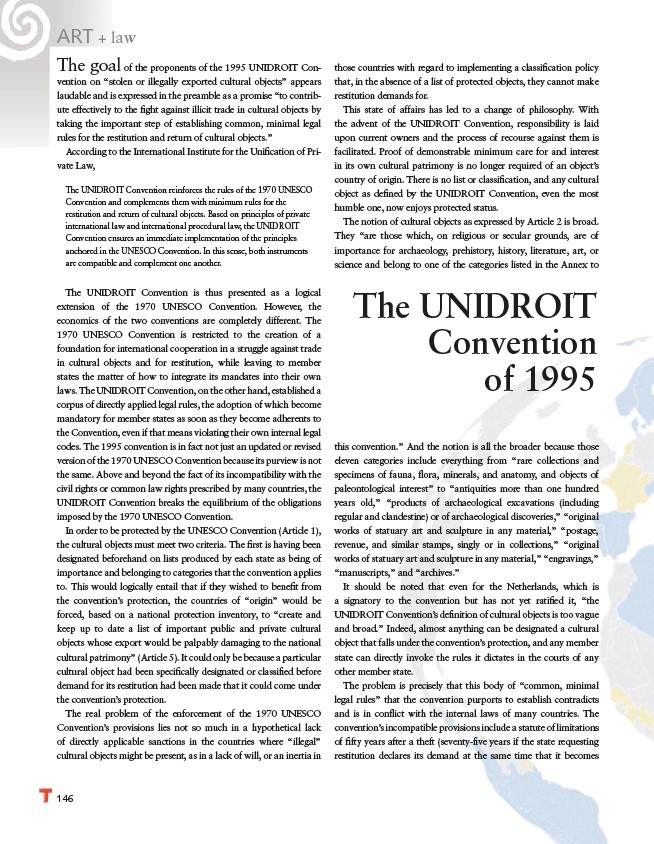
146
this convention.” And the notion is all the broader because those
eleven categories include everything from “rare collections and
specimens of fauna, fl ora, minerals, and anatomy, and objects of
paleontological interest” to “antiquities more than one hundred
years old,” “products of archaeological excavations (including
regular and clandestine) or of archaeological discoveries,” “original
works of statuary art and sculpture in any material,” “postage,
revenue, and similar stamps, singly or in collections,” “original
works of statuary art and sculpture in any material,” “engravings,”
“manuscripts,” and “archives.”
It should be noted that even for the Netherlands, which is
a signatory to the convention but has not yet ratifi ed it, “the
UNIDROIT Convention’s defi nition of cultural objects is too vague
and broad.” Indeed, almost anything can be designated a cultural
object that falls under the convention’s protection, and any member
state can directly invoke the rules it dictates in the courts of any
other member state.
The problem is precisely that this body of “common, minimal
legal rules” that the convention purports to establish contradicts
and is in confl ict with the internal laws of many countries. The
convention’s incompatible provisions include a statute of limitations
of fi fty years after a theft (seventy-fi ve years if the state requesting
restitution declares its demand at the same time that it becomes
The goal of the proponents of the 1995 UNIDROIT Convention
on “stolen or illegally exported cultural objects” appears
laudable and is expressed in the preamble as a promise “to contribute
effectively to the fi ght against illicit trade in cultural objects by
taking the important step of establishing common, minimal legal
rules for the restitution and return of cultural objects.”
According to the International Institute for the Unifi cation of Private
Law,
The UNIDROIT Convention reinforces the rules of the 1970 UNESCO
Convention and complements them with minimum rules for the
restitution and return of cultural objects. Based on principles of private
international law and international procedural law, the UNIDROIT
Convention ensures an immediate implementation of the principles
anchored in the UNESCO Convention. In this sense, both instruments
are compatible and complement one another.
The UNIDROIT Convention is thus presented as a logical
extension of the 1970 UNESCO Convention. However, the
economics of the two conventions are completely different. The
1970 UNESCO Convention is restricted to the creation of a
foundation for international cooperation in a struggle against trade
in cultural objects and for restitution, while leaving to member
states the matter of how to integrate its mandates into their own
laws. The UNIDROIT Convention, on the other hand, established a
corpus of directly applied legal rules, the adoption of which become
mandatory for member states as soon as they become adherents to
the Convention, even if that means violating their own internal legal
codes. The 1995 convention is in fact not just an updated or revised
version of the 1970 UNESCO Convention because its purview is not
the same. Above and beyond the fact of its incompatibility with the
civil rights or common law rights prescribed by many countries, the
UNIDROIT Convention breaks the equilibrium of the obligations
imposed by the 1970 UNESCO Convention.
In order to be protected by the UNESCO Convention (Article 1),
the cultural objects must meet two criteria. The fi rst is having been
designated beforehand on lists produced by each state as being of
importance and belonging to categories that the convention applies
to. This would logically entail that if they wished to benefi t from
the convention’s protection, the countries of “origin” would be
forced, based on a national protection inventory, to “create and
keep up to date a list of important public and private cultural
objects whose export would be palpably damaging to the national
cultural patrimony” (Article 5). It could only be because a particular
cultural object had been specifi cally designated or classifi ed before
demand for its restitution had been made that it could come under
the convention’s protection.
The real problem of the enforcement of the 1970 UNESCO
Convention’s provisions lies not so much in a hypothetical lack
of directly applicable sanctions in the countries where “illegal”
cultural objects might be present, as in a lack of will, or an inertia in
those countries with regard to implementing a classifi cation policy
that, in the absence of a list of protected objects, they cannot make
restitution demands for.
This state of affairs has led to a change of philosophy. With
the advent of the UNIDROIT Convention, responsibility is laid
upon current owners and the process of recourse against them is
facilitated. Proof of demonstrable minimum care for and interest
in its own cultural patrimony is no longer required of an object’s
country of origin. There is no list or classifi cation, and any cultural
object as defi ned by the UNIDROIT Convention, even the most
humble one, now enjoys protected status.
The notion of cultural objects as expressed by Article 2 is broad.
They “are those which, on religious or secular grounds, are of
importance for archaeology, prehistory, history, literature, art, or
science and belong to one of the categories listed in the Annex to
The UNIDROIT
Convention
of 1995
ART + law